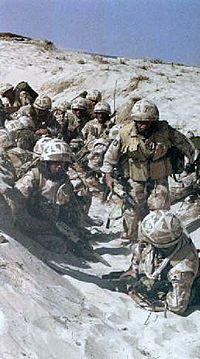Operation Granby facts for kids
Quick facts for kids Operation Granby |
|
|---|---|
| Part of the Gulf War | |

C Company, 1st Battalion The Staffordshire Regiment, in a live firing exercise, during Operation Granby, 6 January 1991.
|
|
| Operational scope | Strategic offensive |
| Location | Ba'athist Iraq, Kuwait, Saudi Arabia, Israel |
| Objective | Iraqi withdrawal from Kuwait; Emir Jaber III restored |
| Executed by | |
Operation Granby was the name for what the British military did during the Gulf War in 1991. It was a big effort to help free Kuwait. Over 53,000 British soldiers, sailors, and air force members went to the Gulf.
The operation cost about £2.4 billion. Most of this money was paid by other countries, like Kuwait and Saudi Arabia. Some military equipment, worth about £200 million, was lost or damaged.
British forces in the Gulf were led by different commanders. Lieutenant-General Sir Peter de la Billière was a main leader on the ground. Air Chief Marshal Sir Patrick Hine was in charge of the overall operation from the UK.
Contents
Royal Air Force

Just nine days after Iraq invaded Kuwait in August 1990, British Royal Air Force (RAF) planes arrived in Saudi Arabia. These included 12 Tornado F3 fighter jets. These jets were used to stop enemy aircraft.
Later, other planes like the Jaguar GR1 and Tornado GR1s joined them. Buccaneer aircraft helped by shining lasers on targets for the Tornado and Jaguar planes. This helped guide their bombs.
These planes helped show that friendly countries were ready to act. They also helped enforce an economic ban on Iraq. The number of Tornado F3s grew to 18, with many pilots and ground crew. They flew patrols to watch Iraqi radar systems. Before the main attack, they flew over 2,000 missions.
Large tanker planes, like the Victor tankers, provided fuel to all coalition aircraft in the air. Transport planes, such as the Hercules and VC10, brought supplies and people. Nimrod planes helped the navy.
The RAF also set up Rapier missile systems to defend against air attacks. In total, about 6,000 RAF personnel were sent to the Gulf.
The RAF and other countries in the coalition wanted to stop the Iraqi Air Force. Iraq had many combat aircraft and missiles. These could not be allowed to help Iraqi ground forces. Coalition forces had three times as many planes as Iraq.
The first part of the Gulf War air campaign focused on the Iraqi Air Force. On January 17, RAF Tornado GR1s flew into Iraq. They attacked Iraqi airbases, which had many defense systems. These attacks were planned together by all coalition forces.
Within 24 hours, the RAF completed 100 missions. After seven days, the RAF started targeting things that helped Iraqi forces in Kuwait. This included oil refineries and bridges over the River Euphrates. Sometimes, bombs missed their targets and hit buildings near bridges, causing civilian deaths.
The RAF played a big role in the air war. They were second only to the United States Air Force. Out of about 55 Allied aircraft lost, eight were RAF Tornados. Five RAF air crew were lost during missions, and three during preparations.
British Army
At first, one British Army armored group was sent to the Gulf. This later grew into the British 1st Armoured Division. The decision was made to send the newer Challenger 1 tanks.
The British Army had about 28,000 soldiers. They had 7,000 vehicles, including 179 Challenger 1 tanks. They also had 316 Warrior vehicles and many artillery pieces.
During the ground war, the 1st Armoured Division moved around the Iraqi forces. They took part in the Battle of Norfolk. British Challenger 1 tanks destroyed about 300 Iraqi tanks. One Challenger tank destroyed an Iraqi tank from three miles away, which was the longest-range tank kill in the war.
The British Army also destroyed many Iraqi artillery pieces and other vehicles. They defeated about five Iraqi divisions in just 48 hours of fighting. Sadly, there was an accident where an American aircraft mistakenly attacked two British Warrior vehicles. Nine British service members died in this incident.
The Royal Navy helped a lot in the early parts of the war. Their Westland Lynx helicopters were very important. They destroyed almost the entire Iraqi Navy in the Battle of Bubiyan.
Royal Navy minehunter ships also cleared Iraqi mines near the coast of Kuwait. This allowed US battleships, the Wisconsin and Missouri, to get close. These battleships then launched powerful attacks against Iraqi ground forces.
HMS Gloucester also shot down an Iraqi Silkworm missile. This missile was heading towards other British ships and the US battleships.
See also
- Operation Granby order of battle
- List of Gulf War military equipment#United Kingdom
- List of British gallantry awards for Operation Granby



